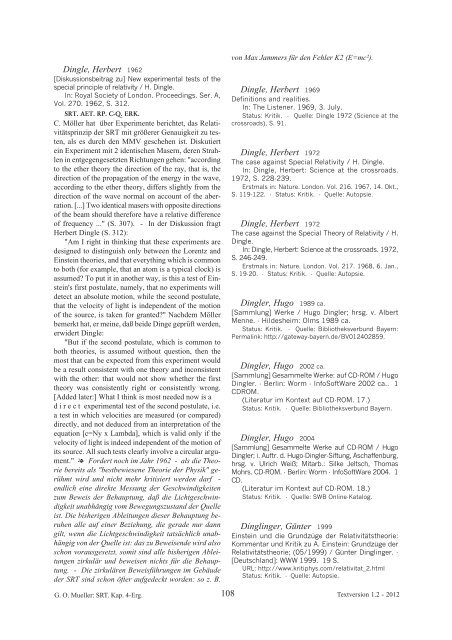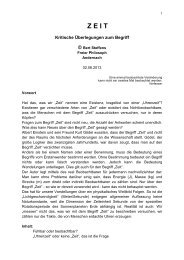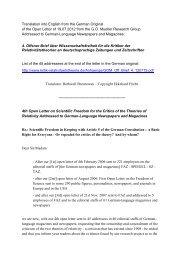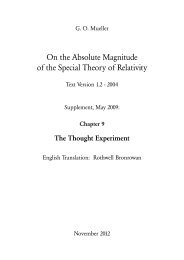2394 weitere kritische Veröffentlichungen - Kritische Stimmen zur ...
2394 weitere kritische Veröffentlichungen - Kritische Stimmen zur ...
2394 weitere kritische Veröffentlichungen - Kritische Stimmen zur ...
Erfolgreiche ePaper selbst erstellen
Machen Sie aus Ihren PDF Publikationen ein blätterbares Flipbook mit unserer einzigartigen Google optimierten e-Paper Software.
Dingle, Herbert 1962<br />
[Diskussionsbeitrag zu] New experimental tests of the<br />
special principle of relativity / H. Dingle.<br />
In: Royal Society of London. Proceedings. Ser. A,<br />
Vol. 270. 1962, S. 312.<br />
SRT. AET. RP. C-Q. ERK.<br />
C. Möller hat über Experimente berichtet, das Relativitätsprinzip<br />
der SRT mit größerer Genauigkeit zu testen,<br />
als es durch den MMV geschehen ist. Diskutiert<br />
ein Experiment mit 2 identischen Masern, deren Strahlen<br />
in entgegengesetzten Richtungen gehen: "according<br />
to the ether theory the direction of the ray, that is, the<br />
direction of the propagation of the energy in the wave,<br />
according to the ether theory, differs slightly from the<br />
direction of the wave normal on account of the aberration.<br />
[...] Two identical masers with opposite directions<br />
of the beam should therefore have a relative difference<br />
of frequency ..." (S. 307). - In der Diskussion fragt<br />
Herbert Dingle (S. 312):<br />
"Am I right in thinking that these experiments are<br />
designed to distinguish only between the Lorentz and<br />
Einstein theories, and that everything which is common<br />
to both (for example, that an atom is a typical clock) is<br />
assumed? To put it in another way, is this a test of Einstein's<br />
first postulate, namely, that no experiments will<br />
detect an absolute motion, while the second postulate,<br />
that the velocity of light is independent of the motion<br />
of the source, is taken for granted?" Nachdem Möller<br />
bemerkt hat, er meine, daß beide Dinge geprüft werden,<br />
erwidert Dingle:<br />
"But if the second postulate, which is common to<br />
both theories, is assumed without question, then the<br />
most that can be expected from this experiment would<br />
be a result consistent with one theory and inconsistent<br />
with the other: that would not show whether the first<br />
theory was consistently right or consistently wrong.<br />
[Added later:] What I think is most needed now is a<br />
d i r e c t experimental test of the second postulate, i.e.<br />
a test in which velocities are measured (or compared)<br />
directly, and not deduced from an interpretation of the<br />
equation [c=Ny x Lambda], which is valid only if the<br />
velocity of light is indeed independent of the motion of<br />
its source. All such tests clearly involve a circular argument."<br />
� Fordert noch im Jahr 1962 - als die Theorie<br />
bereits als "bestbewiesene Theorie der Physik" gerühmt<br />
wird und nicht mehr kritisiert werden darf -<br />
endlich eine direkte Messung der Geschwindigkeiten<br />
zum Beweis der Behauptung, daß die Lichtgeschwindigkeit<br />
unabhängig vom Bewegungszustand der Quelle<br />
ist. Die bisherigen Ableitungen dieser Behauptung beruhen<br />
alle auf einer Beziehung, die gerade nur dann<br />
gilt, wenn die Lichtgeschwindigkeit tatsächlich unabhängig<br />
von der Quelle ist: das zu Beweisende wird also<br />
schon vorausgesetzt, somit sind alle bisherigen Ableitungen<br />
zirkulär und beweisen nichts für die Behauptung.<br />
- Die zirkulären Beweisführungen im Gebäude<br />
der SRT sind schon öfter aufgedeckt worden: so z. B.<br />
G. O. Mueller: SRT. Kap. 4-Erg.<br />
108<br />
von Max Jammers für den Fehler K2 (E=mc²).<br />
Dingle, Herbert 1969<br />
Definitions and realities.<br />
In: The Listener. 1969, 3. July.<br />
Status: Kritik. - Quelle: Dingle 1972 (Science at the<br />
crossroads), S. 91.<br />
Dingle, Herbert 1972<br />
The case against Special Relativity / H. Dingle.<br />
In: Dingle, Herbert: Science at the crossroads.<br />
1972, S. 228-239.<br />
Erstmals in: Nature. London. Vol. 216. 1967, 14. Okt.,<br />
S. 119-122. - Status: Kritik. - Quelle: Autopsie.<br />
Dingle, Herbert 1972<br />
The case against the Special Theory of Relativity / H.<br />
Dingle.<br />
In: Dingle, Herbert: Science at the crossroads. 1972,<br />
S. 246-249.<br />
Erstmals in: Nature. London. Vol. 217. 1968, 6. Jan.,<br />
S. 19-20. - Status: Kritik. - Quelle: Autopsie.<br />
Dingler, Hugo 1989 ca.<br />
[Sammlung] Werke / Hugo Dingler; hrsg. v. Albert<br />
Menne. - Hildesheim: Olms 1989 ca.<br />
Status: Kritik. - Quelle: Bibliotheksverbund Bayern:<br />
Permalink: http://gateway-bayern.de/BV012402859.<br />
Dingler, Hugo 2002 ca.<br />
[Sammlung] Gesammelte Werke: auf CD-ROM / Hugo<br />
Dingler. - Berlin: Worm - InfoSoftWare 2002 ca.. 1<br />
CDROM.<br />
(Literatur im Kontext auf CD-ROM. 17.)<br />
Status: Kritik. - Quelle: Bibliotheksverbund Bayern.<br />
Dingler, Hugo 2004<br />
[Sammlung] Gesammelte Werke auf CD-ROM / Hugo<br />
Dingler; i. Auftr. d. Hugo-Dingler-Siftung, Aschaffenburg,<br />
hrsg. v. Ulrich Weiß; Mitarb.: Silke Jeltsch, Thomas<br />
Mohrs. CD-ROM. - Berlin: Worm - InfoSoftWare 2004. 1<br />
CD.<br />
(Literatur im Kontext auf CD-ROM. 18.)<br />
Status: Kritik. - Quelle: SWB Online-Katalog.<br />
Dinglinger, Günter 1999<br />
Einstein und die Grundzüge der Relativitätstheorie:<br />
Kommentar und Kritik zu A. Einstein: Grundzüge der<br />
Relativitätstheorie; (05/1999) / Günter Dinglinger. -<br />
[Deutschland]: WWW 1999. 19 S.<br />
URL: http://www.kritiphys.com/relativitat_2.html<br />
Status: Kritik. - Quelle: Autopsie.<br />
Textversion 1.2 - 2012





